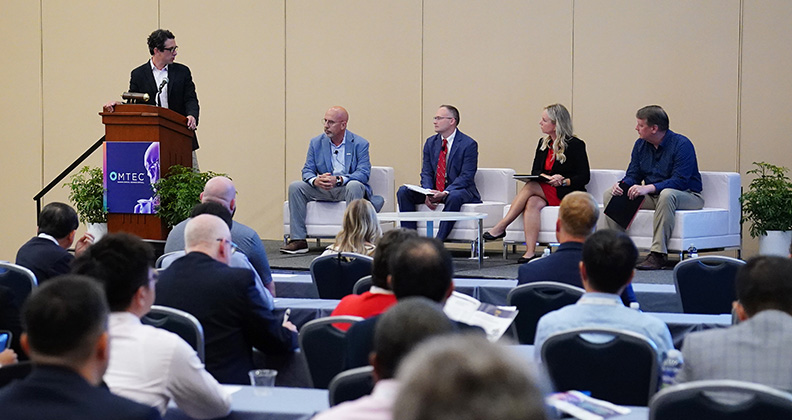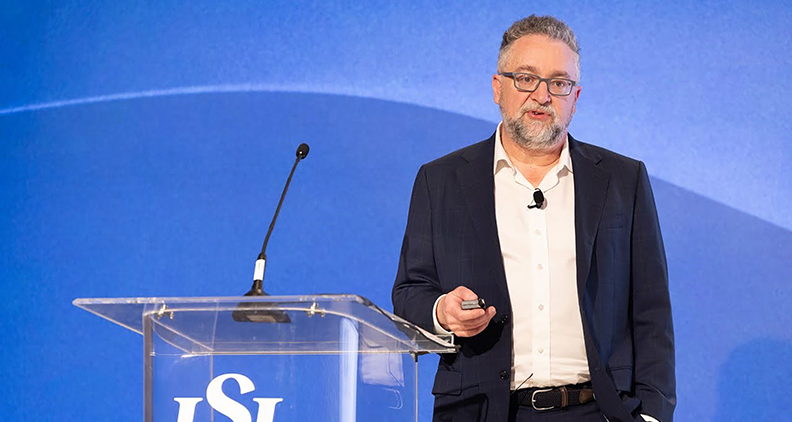
Supply chains that serve the orthopedic industry are being impacted by geopolitical pressures and inherent complexities, forcing OEMs and CMs to focus on building resilience across manufacturing and distribution channels.
At this month’s OMTEC conference, more than 125 attendees gathered for the Supply Chain Symposium, comprising three consecutive sessions that featured insights from OEMs, suppliers and consultants about key supply chain issues in today’s volatile business climate. Topics included ways to respond to the evolving U.S. tariff policies, how AI can lead to more agile and responsive product flow and actionable strategies for working through today’s common sourcing challenges.
Navigating the Supply Chain Climate
ORTHOWORLD’s Senior Editor Dan Cook opened the symposium by moderating a wide-ranging discussion that emphasized the importance of adhering to good supply chain fundamentals, even amid global uncertainty. He addressed that uncertainty by immediately raising the issue of how to cope with tariffs.
Kim Doyle, Partner at Plante Moran, had some suggestions. “The biggest advice we are giving our clients is to continuously monitor the situation,” she said. “Whether it’s appointing a single individual or group of individuals to track developments, it’s critical to make sure your company always has a good handle on what’s changing.”
Doyle’s second piece of advice involved documenting everything related to tariffs, as the situation is likely to remain uncertain for many months. “There’s a chance that some tariffs could get overturned,” she said. “If so, there is speculation that there could be possible credits and refunds. You need to have everything well-documented so you can go after any funds that become available.”
The more uncertain the sector, the more critical it is for OEMs and CMs to collaborate closely as strategic partners, said John Ruggieri, Senior Vice President of Business Development at ARCH Medical Solutions.
“It’s always nice to know what’s next for your customers in terms of new product introductions (NPIs), with just enough detail about their innovation pipeline to tell you where your investments need to be made so that you can be ready for that next project,” he said. “The earlier you can become part of the conversation, the more likely you are to get the process right for your customer, bringing success to both of you.”
Key attributes in this scenario are frequent communication, transparency, flexibility and shared commitment to competitiveness, Ruggieri added.
Kelly Lucenti, Commercial President of Millstone Medical Outsourcing, noted that it has never been more critical to manage Tier 2 and Tier 3 suppliers. “We’ve learned how valuable it is and how much the OEMs need our help and support,” he said. “So, we’ve really wrapped our arms around it.”
After assembling a team of experienced workers to manage Tier 2 and Tier 3 suppliers, Millstone created a portal to allow their customers to see products traveling throughout the supply chain.
“They also have full visibility of inventory levels and when they should expect the shipment based on the products that we’re processing,” Lucenti said. “We’ve gotten the message from our customers not to let anything going on in the world impact our ability to have delivery points fully in. We procure first, then figure out if there are extra costs involved.”
Finally, Mark Pallo, Global Sourcing Director at Zimmer Biomet, reiterated the importance of close OEM/CM relationships. “We need our supply base and our CMs to help us stay competitive and share what they’re seeing from their perspective so that we can integrate that feedback and make us both successful,” he said. “Everybody on both sides must make money and be able to reinvest for either side to succeed.”
Exploring the Power of AI
Next, two executives from the AI-first procurement and supply chain organization GEP took to the stage. Joel Johnson and Vikas Kumar Yadav, both Vice Presidents of Consulting at GEP, discussed the rapidly accelerating adoption of generative AI technology, particularly AI agents, in the procurement and supply chain landscape.
The pair argued that the continued uncertainty of the global supply chain makes disruption the rule, not the exception, and that AI models can be deployed effectively to streamline and automate various procurement processes.
Johnson noted that AI technology is both scalable and flexible.
“If you have the ability to install Microsoft Teams as an SaaS application on your computer, then you have the ability to leverage Microsoft Copilot and create a multimodal agent,” he said. “The costs keep coming down and the models keep getting smarter, and we think the biggest constraints [to AI adoption now] are more oriented around the governance, the creativity and the cultural adoption of this technology.”
Johnson and Yadav then shared two use case studies that examined AI’s ability to detect contract value leakage and validate automated purchase requisition. “AI agents are able to perceive, reason and execute end-to-end workflows, freeing up procurement teams to focus on more strategic activities,” Johnson said.
The adoption of AI needs to be very balanced, according to Yadav. “Your workforce needs to be AI literate. Make sure the users are trained on how to evaluate the model outputs, and ensure there is a human in the loop monitoring the output on an ongoing basis.”
Yadav noted that the AI revolution is accelerating, and that the current procurement landscape will be unrecognizable in a few years. “This change is underway right now,” he said. “A lot of companies are working on bringing it to life.”
Sourcing Challenges and Opportunities
In the third session, Carolyn LaWell, ORTHOWORLD’s Chief Content Officer, moderated a panel discussion on sourcing challenges for orthopedic companies. While navigating the complexities of the supply chain can be daunting, it’s also an opportunity to innovate and ensure that your network is made up of strategic partnerships and not just transactional relationships, she said.
Ben Thompson, Chief Commercial Officer at Avalign Technologies, noted the importance of organizational alignment between OEMs and CMs.
“Once you can answer the question of why you should be in business together, it becomes a question of how well you can align your companies,” he said. “Foundational and strategic partnership involves transparency in both directions.”
Experienced supply chain leader Bridgette Hinojosa said that executing a strategic sourcing strategy involves defining a long-term plan. “You’ll want to segment the market, build a go-to-market approach and align the organization around ‘one company’ thinking rather than siloed business units,” she said.
Ben Rennie, Supply Chain Manager at Choice Spine, has found his thinking influenced by the current situation with tariffs and the spotlight it’s put on the need for corporate flexibility. “It’s really about finding that your quality management system is flexible enough to move internationally when needed and then pull back, when necessary,” he said.
The panelists also noted that global sourcing can provide cost savings but also introduces constraints around landed costs, regulatory compliance and lead times that require careful management. They also noted that as businesses grow and acquisitions occur, sourcing teams must take a step back to evaluate the entire supply base.
“Companies need to assess what is coming in, determine how many suppliers they want to work with and how many they realistically have the capacity to manage,” Hinojosa said. “From there, they can begin the process of consolidation and identifying which suppliers best align with the company’s needs and long-term strategy. This allows them to focus their efforts, develop targeted game plans and ensure those strategies support the company’s goals moving forward.”
Rennie said the key to supplier consolidation starts with strategy. First, you need to take a clear look at your current suppliers and identify the roles they play. What capabilities are they fulfilling, and do you have backup options in place? Are there other suppliers that can step in if a key partner runs into issues?
The panelist also discussed the opportunities that exist in OUS regions.
“What’s really exciting about exploring international markets is the opportunity to leverage cost savings,” Rennie said. “However, there are challenges that people don’t always anticipate, one of the biggest being landed cost.”
For example, he noted that freight could significantly impact your bottom line because certain shipping lanes can drive up costs to the point where initial savings obtained in the international market are essentially wiped out.
OEMs that pursue a global sourcing strategy must have both the time and contingency plans in place to move quickly when needed, according to Thompson.
“We’re seeing more situations in which products manufactured overseas are now being brought back to the U.S., and OEMs are reaching out to CMs for help,” Thompson said. “By the time those calls come in, it’s often too late to respond efficiently. So, if you’re committed to a global strategy, make sure your backup plan is well-developed and capable of handling both the scale and the speed required. That’s where many companies are hitting a bottleneck today.”
DL
Darcy Lewis is a contributing writer.




